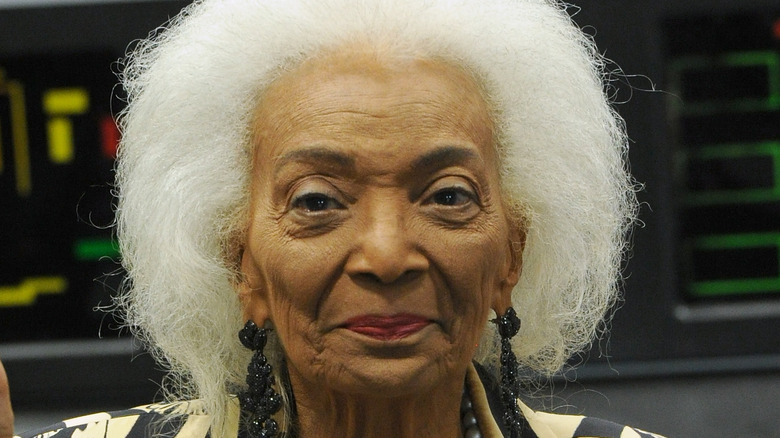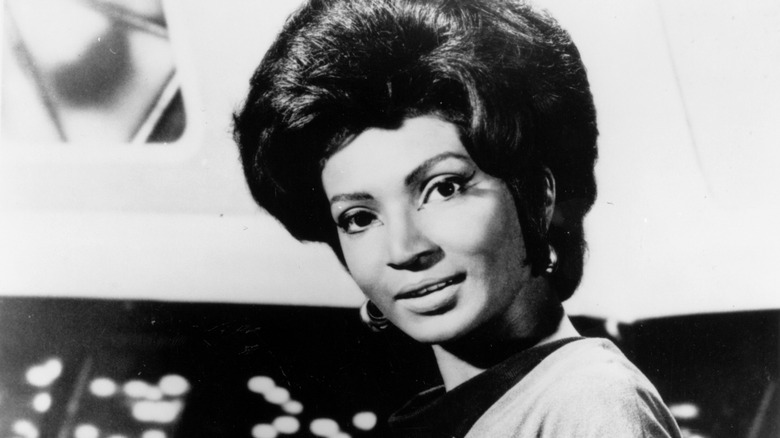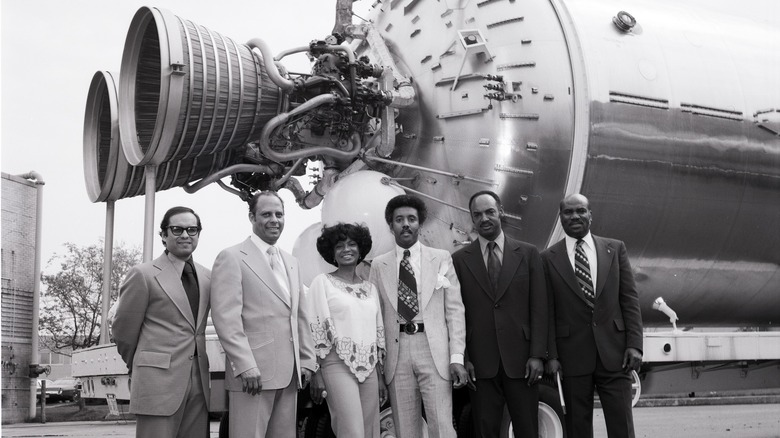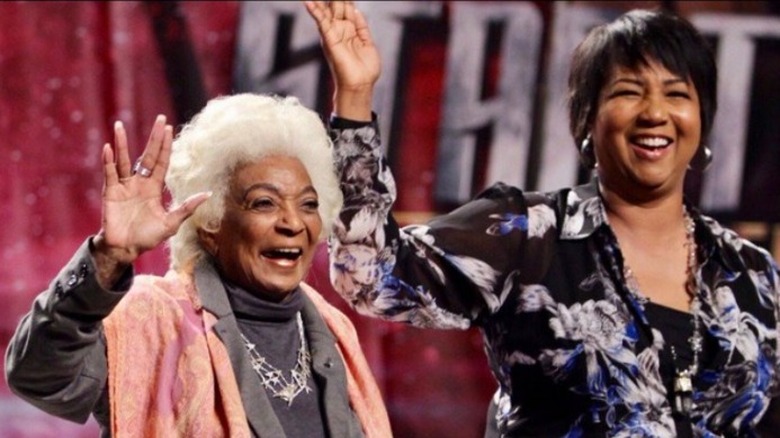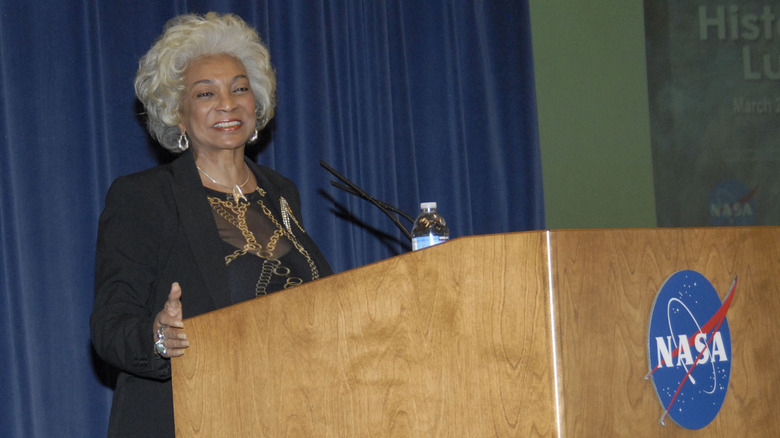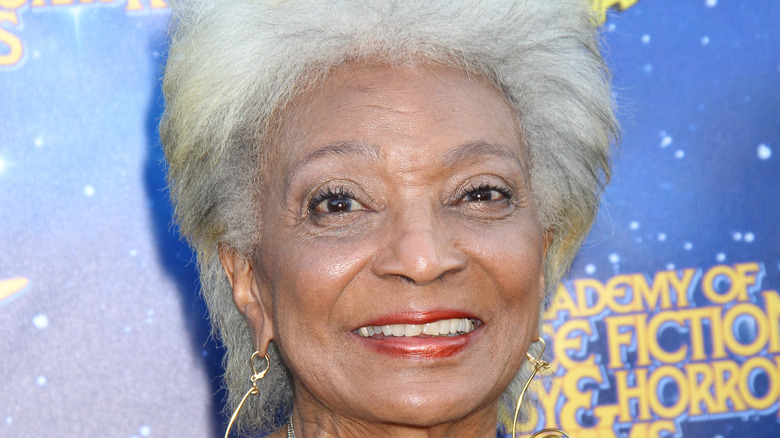Star Trek Star Nichelle Nichols' Dedication To NASA Was Nothing Short Of Remarkable
On July 30, 2022, the galaxy bid a heartbroken farewell to the first lady of space, Nichelle Nichols. Nichols, who "succumbed to natural causes" at the age of 89, according to a Facebook post from her son Kyle Johnson, leaves behind not only warmth and love, but a multigenerational legacy that's inspired countless individuals to chase the stars. Nichols was best known for her role as communications officer Lieutenant Nyota Uhura on the original "Star Trek," where she — like her linguistically-minded character — bridged the gap between peoples of various races, ages, classes, and creeds. "You are changing the minds of people across the world," Martin Luther King, Jr. once told her, in encouraging her to not leave her role on "Star Trek," "because for the first time, through you, we see ourselves and what can be" (via PBS).
Many people might not know, though, that Nichols didn't just change hearts and minds, but the course of actual, historical spaceflight. Following her career-defining role on the original "Star Trek" series, which aired from 1966 to 1969 (and would later be adapted into six feature films in which Nichols starred), Nichols became NASA's personal recruitment ambassador. This wasn't a passive, incidental decision, either. Nichols was frustrated that, even by the late 1970s, NASA didn't hire women and non-white people, as the 2019 documentary, "Woman in Motion," discusses. So, she went to Washington D.C. and called NASA out. The following day, as NASA reports it, the agency invited Nichols to NASA Headquarters to help the agency campaign for scientists, engineers, and astronauts who were, in Nichols' words, "my people."
A woman in motion
Nichelle Nichols might have finished her fictional television journey to space in 1969, but it was less than a decade later that she began her actual journey to space. Not content to rest on her laurels after wrapping on "Star Trek," Nichols formed her own education-through-music company, Women in Motion, in 1975, as The History Makers states.
Music, in fact, was Nichols' first love. Nichols toured with Duke Ellington as a choreographer and singer, and moved to Los Angeles as a stepping stone on her way to musical theater. As Deseret News quotes her as saying, "I took 'Star Trek' because I thought it would be a nice adjunct to my resume and I'd get to Broadway quicker and as a star." Nichols was ready to head out when season one of the show was wrapping up, despite falling in love with the show's writing and realizing that Gene Roddenberry was writing "morality plays," as she told the BBC. And yet, thanks to encouragement from Martin Luther King, Jr., she stayed in her role, as CNN recounts.
Come 1977, when NASA stated that it wanted to hire Nichols to help the agency recruit people of minority status, NASA gave Nichols' educational company a grant to expand the scope of its enterprise. Women in Motion became the vehicle for encouraging the Black community, particularly women, to join NASA. Nichols starred in short recruitment films like those archived on YouTube.
The driving force for NASA recruitment
Nichelle Nichols demonstrated relentless passion about spaceflight, science, and the role of NASA in society. As CNN cites, she said, "Science is not a boy's game, it's not a girl's game. It's everyone's game. It's about where we are and where we're going. Space travel benefits us here on Earth. And we ain't stopped yet. There's more exploration to come." As NASA quotes, she said with similar verve, "These missions show what mankind can dream of, mankind can do... We have not only the opportunity, but the duty to keep the space program viable where no man or woman has gone before."
It's this drive that kept Nichols campaigning for new NASA recruits through the 1980s. Without exaggeration, she almost single-handedly shaped the face and personnel of NASA moving into the present age. Among those she recruited, as Space explains, was the first Black astronaut Guion Bluford, the second Black astronaut Ronald McNair, the first female astronaut Sally Ride, and Judith Resnik, another female astronaut who along with McNair sadly died during the Challenge accident in 1986.
It's important to remember that, as an actual recruiter, Nichols handpicked candidates to recommend to NASA; she wasn't merely just a celebrity posing for photos. And by all accounts, Nichols excelled in her role. This is quite a statement, considering that in 2021, for instance, NASA only accepted 12 out of 18,353 candidates (via CNBC).
Inspiration for countless people
Nichelle Nichols went above and beyond during her tenure as recruiter at NASA. She not only inspired people on the whole, but worked hard on a personal level to encourage specific individuals to stick with their dreams. Take the case of Mae Jemison, NASA's first Black female astronaut. As NASA states, Jemison first applied in 1983, but was rejected. Nichols circled back to her four years later in 1987 and asked her if she wanted to re-apply. Jemison did and was accepted. By 1992 she was aboard the shuttle Endeavor. Nichols was also responsible for recruiting notable NASA administrator Charles Bolden, who was commander on four space missions, logged over 680 hours of space flight, and became NASA's 12th administrator in 2009 (via NASA).
Aside from those individuals whom Nichols personally brought into the NASA fold, plenty of other NASA personnel cite either Nichols specifically or "Star Trek" as a whole for making them interested in space and science. NASA's first female launch director, Charlie Blackwell-Thompson, told Space, "What I love about Nichelle Nichols is how she embraced the role [of Uhura], and how she portrayed us and gave us that roadmap for the future generation of women to follow." NASA's Dryden Center Director David McBride said of the original "Star Trek" series. "We are seeing things like electronic readers and wireless communicators. The first place we saw that was on the bridge of the Enterprise and Lt. Uhura was in charge of it."
A lifelong advocate of space flight
Nichelle Nichols remained committed to NASA's mission and deeply tied to the agency throughout her entire life. In 2013, for instance, she gave a talk at NASA's Dryden Flight Research Center, which conducts testing on aeronautics, propulsion, and other space-related technology, as the center's website explains. Nichols spoke of her experiences getting involved in "Star Trek" and recruitment for NASA, and was able to tour the facility, as NASA explains.
Two years later in 2015, Nichols joined a team of researchers on a mission on the shuttle SOFIA, the Stratospheric Observatory for Infrared Astronomy. As SOFIA's original tweet states, the mission involved studying star formation and the "evolution of planetary construction material." Aside from donning an official NASA jumpsuit, Nichols also received some companionship for the trip in the form of a stuffed Tribble, which is a small furry fiction creature from the "Star Trek" universe, as the Daily Dot reports. In 2016, as NASA states, Nichols' made a visit to NASA's Jet Propulsion Lab where she met systems engineer Tracy Drain, yet another NASA employee who cites Nichols as her inspiration.
In 2019, the documentary "Woman in Motion" was released, which chronicled Nichols' role in recruiting underrepresented people into the sciences and aeronautics. It especially focused on NASA's initial intense 1977 four-month push to search for promising candidates. Thanks to Nichols' efforts, the agency garnered 8,000 recruits. Films such as these have helped the general public became more aware of Nichols' involvement with NASA.
Guide to the stars
Thankfully, Nichelle Nichols didn't have to wait until she passed away to be properly credited for her efforts. As early as 1984, as The History Makers cites, she received NASA's Public Service Award which recognized her work and the impact of it. On the entertainment front, she was also the first Black actor to receive handprints in front of Hollywood's Grauman's Chinese Theatre in 1992. IMDB lists her other awards, such as a Lifetime Achievement Award from the Academy of Science Fiction, Fantasy, and Horror, and an NAACP Image Award.
As impactful as Nichols was on NASA, she was equally warm, inviting, and kind with fans of all stripes. She toured relentlessly at conventions, month after month, year after year, as an exhaustive list on FanCons shows. Her final appearance in December, 2021 at Los Angeles' 2021 Comic Con, less than year before her death.
Along those lines, the aforementioned Mae Jemison, whom Nichols encouraged to apply to NASA for a second time, said to People, "One of the things that you've heard everyone say when they talk about meeting and spending any time in Miss Nichelle Nichols' presence is warmth and generosity. And you feel like you've known her, because she is that real, not just relatable, but that important and sentient in our live." She then added, "She said to me, 'Life is what the universe gave you for free when you were born. But style is what you do with it.'"
